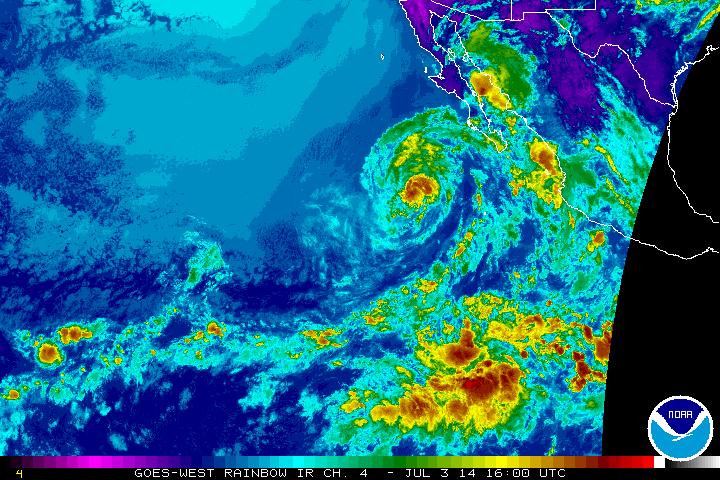Tropical Storm Douglas Weakening in the Eastern Pacific

NOAA's GOES-West satellite's infrared data from July 3 at 9:15 a.m. EDT showed Douglas appeared less organized and less-round than the day before. Image Credit: NASA/NOAA GOES Project
NOAA's Geostationary Operational Environmental Satellite or GOES-West satellite captured visible data on Douglas just after sunrise on July 3 at 13:15 UTC (9:15 a.m. EDT).
The data from GOES-West was made into an image at NASA/NOAA's GOES Project at the NASA Goddard Space Flight Center in Greenbelt, Md.
Forecaster Stewart at the National Hurricane Center cited that Douglas' thunderstorm activity had been gradually waning during the early morning hours on July 3 and infrared data, such as that from the Atmospheric Infrared Sounder instrument aboard NASA's Aqua satellite showed that cloud tops were warming, which indicates cloud heights were falling and the uplift of air in the storm was weakening.
Despite that, microwave satellite data from NOAA's AMSU instrument and NASA's Tropical Rainfall Measuring Mission satellite indicated that Douglas had maintained a tight low-level circulation including a shallow eye-like feature.
On July 3 at 5 a.m. EDT (9:00 UTC), Douglas' maximum sustained winds were near 40 mph (65 kph) and the storm was weakening.
The center of Douglas was located near latitude 20.4 north and longitude 116.5 west, about 455 miles (735 km) west-southwest of the southern tip of Baja California, Mexico. Douglas is moving toward the northwest near 3 mph (6 kph).
The NHC expects Douglas to become a tropical depression late on July 3 and degenerate into a remnant low pressure area by the fourth of July.
Text credit: Rob Gutro
NASA's Goddard Space Flight Center
Media Contact
More Information:
http://www.nasa.gov/content/goddard/douglas-pacific-ocean/All latest news from the category: Earth Sciences
Earth Sciences (also referred to as Geosciences), which deals with basic issues surrounding our planet, plays a vital role in the area of energy and raw materials supply.
Earth Sciences comprises subjects such as geology, geography, geological informatics, paleontology, mineralogy, petrography, crystallography, geophysics, geodesy, glaciology, cartography, photogrammetry, meteorology and seismology, early-warning systems, earthquake research and polar research.
Newest articles

Economies take off with new airports
A global study by an SUTD researcher in collaboration with scientists from Japan explores the economic benefits of airport investment in emerging economies using nighttime satellite imagery. Be it for…

CAR T–cell immunotherapy targets
Pan-cancer analysis uncovers a new class of promising CAR T–cell immunotherapy targets. Scientists at St. Jude Children’s Research Hospital found 156 potential CAR targets across the brain and solid tumors,…

Stony coral tissue loss disease
… is shifting the ecological balance of Caribbean reefs. The outbreak of a deadly disease called stony coral tissue loss disease is destroying susceptible species of coral in the Caribbean…





















